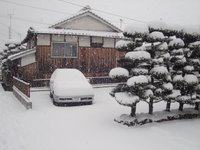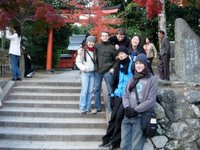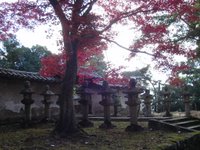Talking a bit about the last weekend and this week. Noticed that I haven't post much about what happens here except festivals. I'll just write the highlights though.
Saturday (oct 29th). Aikido examination in the morning. For those who don't know I'm trying to learn aikido with the university's aikido club. Still have some difficulties, but it's been interesting so far. Language barrier is more a good subject to chit-chat than a problem (in last case they simply show me with gestures how it's done), although I still have difficulties understanding reports and messages. Anyway, it's being good so far, and I've made some friends too. Back to the exam, I still have to improve a lot. Guess it's the result of skipping so many trainings during the first semester. At least I think I'll be able to go up a level (kyu).
Later, some presentations from junior high and high school students who spent some weeks in a host family in Himeji's sister cities. Seems that they have show something about what they've learned/visited/whatever there. Various stuff from a japanese garden in Phoenix (USA), differences between Korean and Japanese temples to a little opinion poll about how Japanese see Chinese and vice-versa. Good things considering that they're school students who have stayed less than a month abroad. By the way, presentations about Himeji's Brazilian sister city (Curitiba) were comparing bus services between the cities (note that Curitiba is a model of bus transportation system...) and comparing lives of nikkeis (Japanese descents) in Brazil with Japanese in Japan (duh...). There was even a graph estimating meal times and so... Just a pity that I couldn't talk to them. Wanted to, but there wasn't no time at all... and since they're wearing school uniforms it was hard to distinguish.
Last but not least, ultimate frisbee with the JETs. I really enjoy playing, people are nice and it's a good chance to work out a little. Need to say more?
Sunday. The festival of the weekend. International Friendship Festival. In short there were places selling food from different countries ("pastel" and "canjica" from Brazil. But the best was something from Peru) and some performances like dances from different countries. Went there with Jon and met Ravier (not sure about spelling. First met him playing frisbee...) there. Met other people too, especially foreign friends (like Steff) and teachers. Sorry, but no pics this time. I was too busy eating. XD
Later, went with Jon, Steff and Silvia watch some ballet. "Sleeping Beauty" by the Russian National Ballet Theatre. Impressive and beautiful. Some good culture for a change (my first time watching pro ballet performance). Most of the public was composed of old ladies and kids (mostly girls), though. Maybe, as Steff said, they might be the only ones having time and money (yes... expensive somewhat) for that. Dinner at our favorite Chinese restaurant for the weekend's grand finale...
Monday. Halloween. Englist test. (Strange combination, isn't it?) Then the teacher enters wearing a Bin Laden costume! That was worth the day! Quoting the Master Card ad:
"Alarm clock: X yen"
"Textbook: Y yen"
"Bin Laden costume: Z yen"
"Seeing the students' face when 'Bin Laden' enters the classroom: priceless"
Plus, the terrorist costume was sooo appropriate for a test day... XD Should've taken a picture... Think I'll ask one of my colleagues who took some. (Note: the test itself wasn't so hard... at least for me...)
Tuesday. Another test. This time Electric Circuits. As I've studied that before, I thought I'd have more problems understanding the questions (in Japanese) than solving them, but I found out that I'm a bit rusty... and teachers can always come with tricky questions. I think I did well... There was a strange question, though... Anyway, the point was after the test. That was the first time I made a test and could stay and talk to other colleagues (usually, due to the fact that my timetable doesn't match any other students' I or they have to go elsewhere immediately after). It was nice having some chit-chat about the test... and useful to confirm that students are all the same here or there. That also brought memories of discussions with friends after tests in Brazil...
Wednesday. As Thusday's gonna be a holiday, the gang gathered to go bowling at night. Before that, the classic meeting at Starbucks... the rendezvous point for foreigners in Himeji. Meeting people here and there I found someone who's studying Portuguese! That's a first! There was also a Japanese who studied Portuguese in college (the reason was the necessity of learning it because of all the Brazilians coming to Japan... something like that). I volunteered to help, if needed...
In the end the Bowling group was Steff, Jo, Michelle, Rezaur, Jon (another one), Greg and me. If anybody asks me, my bowling sucks. Barely scored more than 70... At least some people scored less.
After that, Tigers Pub. Well, there was a drinking game that was the high spot (together with Jon's magic trick of changing 1000 yen bills into 10000 yen... There's someone who withdraws only 1000 yen bills... XD). Basically say the full name of a personality. The next person must say another whose first name starts with the same letter as the first letter of the family name of the name previously spoken. But additional rules make people spend more time drinking than saying names. Like, can anybody communicate well in this situation without using words like "you", "time" (time limit), "drink" or bad words?
Thursday. Holiday. Time to know the festival of the weekend. Seems it's something related with ceramics from various Japanese prefectures. The rest of the day I just hanged around with Jon (the usual one... have to think about some way differentiate between them when writing ) strolling around, staying at Starbucks and playing arcades... Not bad to celebrate the "Culture Day", isn't it?
Nothing really special that I remember on Friday, unless the funny situations between the teacher and a student during English class. But that's beside the point, so let's see what the upcoming weekend will bring.


















